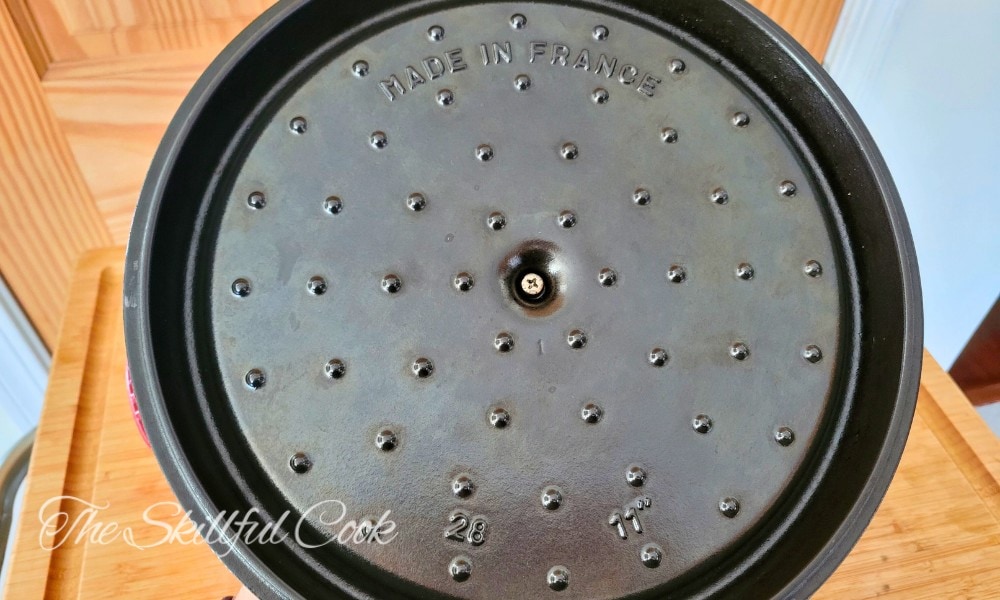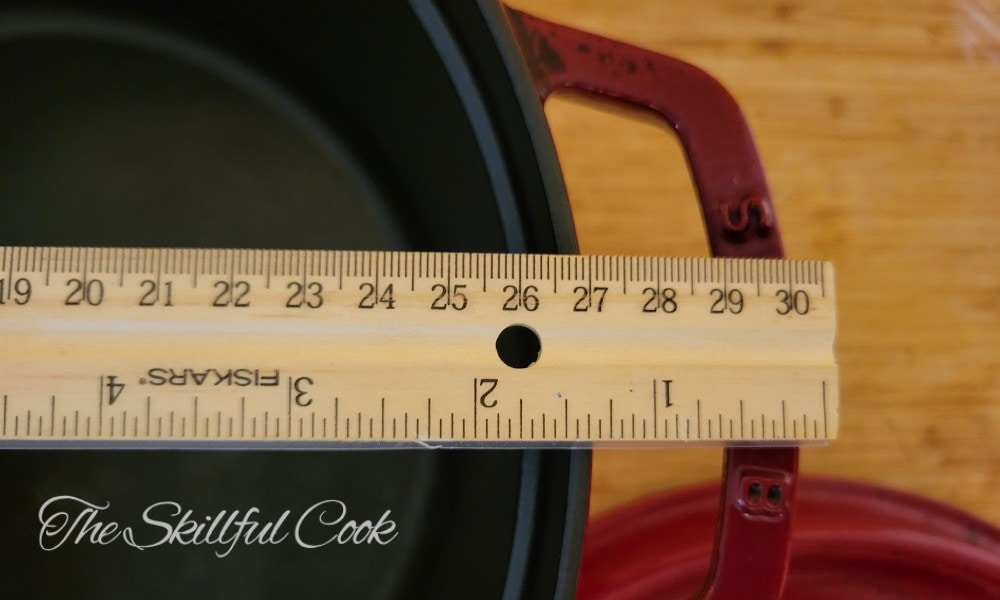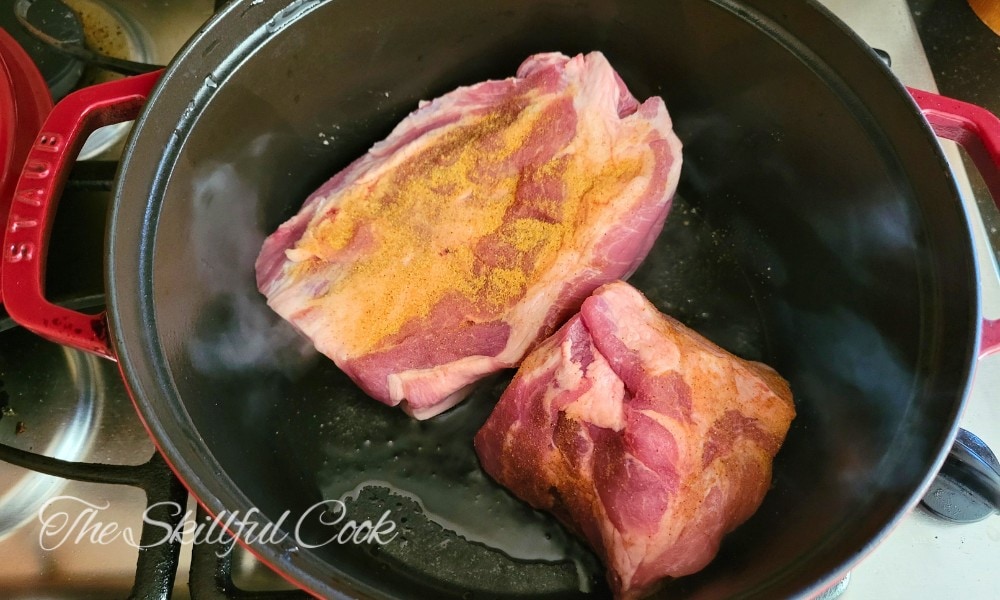Pros
Cons
Le Creuset is the original and most famous enameled cast iron manufacturer, but did you know there is another French brand that might be even better? Yes, I said it, and the testing backs me up! Meet Staub, a brand known for being less of a showpiece, but even more of a cooking machine than Le Creuset.
The Staub cocotte packs nearly the same highbrow appeal as Le Creuset, but at a (slightly) more affordable price. It’s not a budget brand like Lodge, but for the cost, you’re getting a formidable piece of cookware that has great longevity.
I tested all three of these brands in a couple weeks of cooking madness, and came up with some pretty interesting observations!
Side-by-Side Comparison with Other Dutch Ovens
Staub 7qt
Our score:
92/100
Width:
11.75 inches
Diameter:
9 inches
Height with Lid:
6 inches
Weight with Lid:
11.3 pounds
Thickness:
4mm
Country of Origin:
🇫🇷 France
Le Creuset 7.5 qt
Our score:
90.5/100
Width:
11.75 inches
Diameter:
9 inches
Height with Lid:
6 inches
Weight with Lid:
8.2 pounds
Thickness:
3.6mm
Country of Origin:
🇫🇷 France
Lodge 5.5 qt
Our score:
80/100
Width:
14.75 inches
Diameter:
11 inches
Height with Lid:
7.25 inches
Weight with Lid:
12.5 pounds
Thickness:
5.4mm
Country of Origin:
🇨🇳 China
I tested a cherry-red Staub 7 qt Dutch oven that I borrowed from a friend. Originally purchased new from a reputable dealer, it had about two years' worth of mileage on it when I got to test it, so I could see how it held up to time.
Cooking Performance
I never thought I’d give a perfect cooking score. (Between you, me, and the internet, I can be a little picky.) But I like the way Staub cooks very much.
Oven Use
All the Dutch ovens I tested cooked a roast and stew in the oven in roughly half the time it would have taken in my stainless steel roaster, but Staub was the fastest thanks to its self-basting lid.

The lid is flat, instead of domed like a Le Creuset, and features little bumps on the underside that force steam to drip back down into the pot. This feature helps meat cook faster and more evenly. It also mimics a steam-injection oven to put incredible crusts on loaves of bread.
Braising Meat
I put 6 lbs of pork, cut into 1 lb- 1.5 lb pieces, into the Staub to test its braising ability. With the oven set to 300°F (149°C), the cocotte came to a steady temperature in an hour.
The meat smelled amazing at the 2.5-hour mark, and I was surprised to find it was fork-tender and ready to shred for carnitas! The meat in the other Dutch ovens that I tested still had time to go. It took the smaller Lodge another half hour to achieve the tenderness I wanted, while the larger Le Creuset needed another hour. I also credit the tight-fitting lid for keeping in the moisture and helping the meat cook so quickly.
Stovetop Use
The strength of any Dutch oven is in its heat distribution, heat retention, and moisture retention.
To measure these most important features, I boiled 2 quarts of water in all three pots. Set to level 6 on my stove, I tracked the amount of time water took to come from 70°F to a boil (212°F on the thermometer). Then the water simmered for 5 minutes. Once I removed the pot from the heat, I set a timer and checked the internal temperature at 30 minutes, then again at 60 minutes to determine heat retention. Once it cooled down, I measured the water left in the cocotte to check the amount of water loss.

The Staub took a tiny bit longer to come to a boil than the thinner-walled Le Creuset – but it also held the heat longer. Of the three Dutch ovens, the Staub had the highest temperature at the 30-minute mark by 5-10°F, and at the hour mark was still the warmest. It also retained the most water by a significant margin over both the Le Creuset and the Lodge. Check out the details in the chart below.
One note: some cooks prefer a Dutch oven to release moisture when making a stew or roast, allowing the stock to reduce and concentrate the flavor. So Staub’s great steam retention may be a pro or a con, depending on what you’re cooking.
| Le Creuset | Staub | Lodge | |
|---|---|---|---|
| Time to 212°F | 8 min 38 sec | 9 min 10 sec | 9 min 44 sec |
| Temp at 30 min | 161°F | 166°F | 156°F |
| Temp at 60 min | 130°F | 132°F | 127°F |
| Water retention | 91.8% | 95.3% | 87.5% |
Full Comparison: Staub vs Le Creuset vs Lodge Dutch Ovens
Searing - All About the Black Enamel
You’re never going to get an award-winning sear on a steak using a Dutch oven. But of the three I tested, the Staub was the most satisfactory. Like other brands, a Staub cocotte is coated in porcelain enamel on both the inside and outside of the pot. But unlike many others, the Staub interior enamel is colored black. It’s also infused with a quartz grit, rather than finished smooth.
This grit grips meat and achieves a decent sear. But the black enamel has its drawbacks. For one thing, it tempts you to treat the pot like regular cast iron. It feels like you should be able to use metal utensils on it. It feels like you should be able to turn up the heat. It’s easier to leave carbonized crud on it when you’re cleaning it since you can’t see stains. And it’s a lot harder to monitor the condition of the enamel since you can’t see scratches.

The interior enamel of the Staub oven I tested definitely showed some wear – but it was hard to tell whether it was staining that could be removed with an acid-based cleaner, or whether it was actual damage to the enamel.
Build Quality
Staub enameled products are engineered and manufactured in France.
The walls of the 7 qt Staub cocotte are 4.0mm thick. This makes the pot slightly heavier than a Le Creuset with 3.6mm walls. But the budget Dutch ovens I’ve handled – Lodge and Aldi – both have thicker walls and weigh more per quart than either of the high-end brands.
I found the Staub to be a great happy medium in terms of weight and thickness. It’s clearly built very well. There were stains on the interior and exterior enamel, but the enamel wasn’t visibly cracked or damaged.
Design and Comfort
A Staub Cocotte has its own aesthetic; not as sophisticated as a Le Creuset, and with a less refined color gradient. But Staub is a well-designed piece of cookware, which you can customize with replaceable decorative knobs. (When I get my own, I’m buying the rabbit knob!) The cocottes also come in fun shapes like pumpkins or hearts.
Staub’s handles are textured for a better grip, but they don’t provide as much space for your fingers as Le Creuset.

Versatility
As Dutch ovens go, Staub is extremely versatile. It performed well on every task I gave it, from baking bread to making pulled pork in record time.
Enameled cast iron can transition easily between the stove and fridge, but you must give it time to come to room temperature in between. A rapid temperature change can lead to thermal shock, which will damage the enamel.
While the Staub can do a lot, it can’t stand up to metal utensils – despite the dark-colored enamel. It can withstand oven temperatures to 500°F, but shouldn’t be used on high on the stovetop. It is, however, compatible with all kinds of stovetops, from gas to electric to induction.
Just be careful when heating any cast iron on induction; if you don’t bring it up to temperature gradually, it may crack.
Ease of Use and Maintenance
A Staub cocotte is relatively easy to care for. If the enamel is intact, it doesn’t require seasoning, like bare cast iron. But of all the enameled Dutch ovens, Staub’s textured interior is most likely to take seasoning well if you choose to try it. If the interior enamel has worn away from use or abuse, you’ll want to season it for sure. Avoid seasoning the exterior enamel, or it will become sticky, discolored, and hard to handle.

According to Zwilling, Staub’s parent company, you can put a Staub cocotte in the dishwasher. Or you can wash it with mild soap and a soft sponge. The 7-quart cocotte was a bit heavy to wash by hand, but it wasn’t too cumbersome.
Longevity and Warranty
Staub is in it for the long haul. Made in France by the German company Zwilling JA Henckels, Staub offers a fantastic warranty. Even better, reports from across the internet indicate that they honor that lifetime warranty, unlike some cheaper brands.
If your Staub product does have an issue, you will be offered a replacement, not a repair. So if that Dutch oven has sentimental value, don’t send it in, as it will be recycled after inspection.
Unless you’re very hard on a Staub product and drop it, scratch it, or leave it empty on a burner, it should last for many years. It will stain over time, but its original finish can be restored with some TLC.
Price and Availability
Purchasing Staub is not as easy as strolling into Walmart and grabbing it off the shelf. Staub is available from high-end retailers like Sur La Table or Williams Sonoma, but the easiest place to find it is Amazon! You can also purchase it from the Zwilling website.
Staub can’t compete with Chinese-made brands like Lodge, Cuisinart, or AmazonBasics for sheer affordability – but it outshines these brands in durability and longevity. And it’s generally cheaper than Le Creuset.
For instance, a 5.5 qt Le Creuset French oven may cost between $350 to $400 without sales. The prices vary on Staub but a 5.5 qt Cocotte will cost around $300. It’s also much easier to find sales and deals on Staub than Le Creuset.
Health and Safety Considerations
Many doctors and experts consider enameled cast iron to be among the safe cookware options.
Some users are torn on the safety of enameled cookware. We explore all of these concerns in the linked article, but here are a few must-know facts about Staub enameled cast iron.
To learn more about this, check out this related post: Is Staub “Non-Toxic” And Safe To Use?
Company and Environmental Impact
Zwilling is the parent company of Staub cookware. It is working towards becoming climate-neutral by 2030. Zwilling releases a yearly sustainability report and is FSC-certified. You can look up regulatory information on specific products through their product regulations compliance portal. However, like Le Creuset, Zwilling also manufactures nonstick cookware with coatings that contain PFAS.

Products that are sent in as part of their warranty program are promptly recycled.
Unlike some products that wear out as quickly as 6 months after purchase, Staub is made to last for decades, if not generations. When properly cared for, you’ll be keeping junk cookware and its synthetic polymers out of the landfill.
FAQ
Is a Cocotte the Same as a Dutch Oven?
A cocotte and a Dutch oven are such similar pieces of cookware that the terms can be used interchangeably. Some people consider a cocotte to be smaller and more decorative than a Dutch oven. Dutch ovens can be made of raw cast iron, while a cocotte is usually coated in porcelain enamel. Roughly translated, “La Cocotte” means “casserole dish” in French.
What Else Do People Say About It?
Staub receives a 4.7-star review on Amazon, from over 3500 reviews. Customers like the value, heat distribution, and quality of the cocotte. The reviews mention that the beautiful and vibrant Staub enameled cast iron Dutch oven retains heat well and cooks evenly without burning. By and large, customers find it well worth the price. Customers are also satisfied with the ease of cleaning.
Opinions are divided on the coating and weight, so do keep in mind that the larger the cocotte you purchase, the heavier it will be, especially when it’s full of food.
Conclusion
So after testing a Staub cocotte, would I buy one Staub for my own kitchen? I absolutely would. In fact, I didn’t want to return this one (but I did, because I love my friend slightly more than her wonderful cocotte.)
Staub should hold up to years of use, and if it doesn’t, I’m confident the company will stand by its product warranty. Of the three Dutch ovens I tested, Staub fit my cooking preferences the best.
But what about you? Does it sound like a Staub cocotte belongs in your kitchen? Are you more the Le Creuset type? Or does paying more than $200 for a single pot sound like a silly investment? Let us know in the comments if there’s anything else we should cover in our review!















